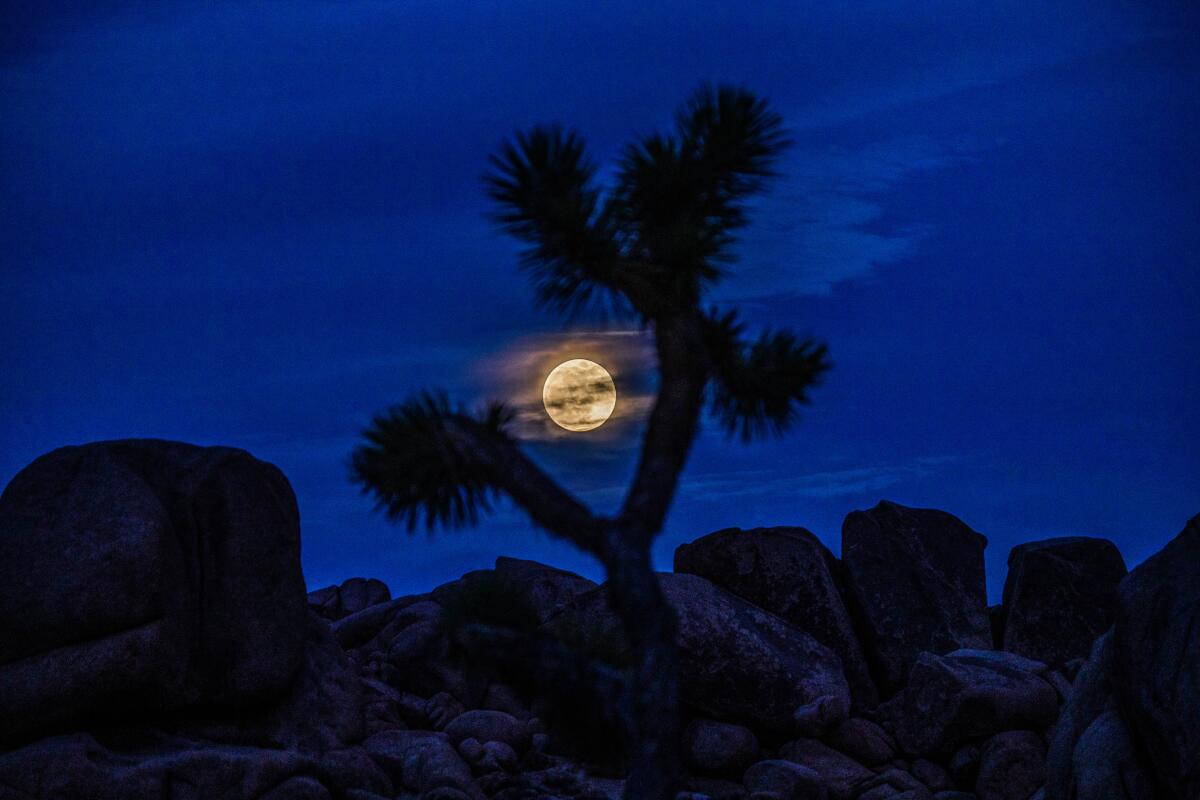
25 best California experiences to add to your winter bucket list
Egg nog is not enough. A new pair of slippers is not enough. A dab of cranberry sauce on a holiday plate is definitely not enough. To spice up this winter and put all the waiting and wondering of 2022 behind us, I’m thinking we need something more profound. An adventure. Or maybe 25 of them.
So I’ve pulled together this roster of California winter experiences, from skiing and boarding down mountains to building driftwood forts and slurping cool, fruity desert refreshments.
Before you head to any of these places, check websites (and maybe make a phone call or two) to be sure what each destination’s latest ground rules are for vaccination, masking and occupancy.
If I’ve missed something great, send me a note on Twitter, Instagram or at christopher.reynolds@latimes.com. Or let us know here.
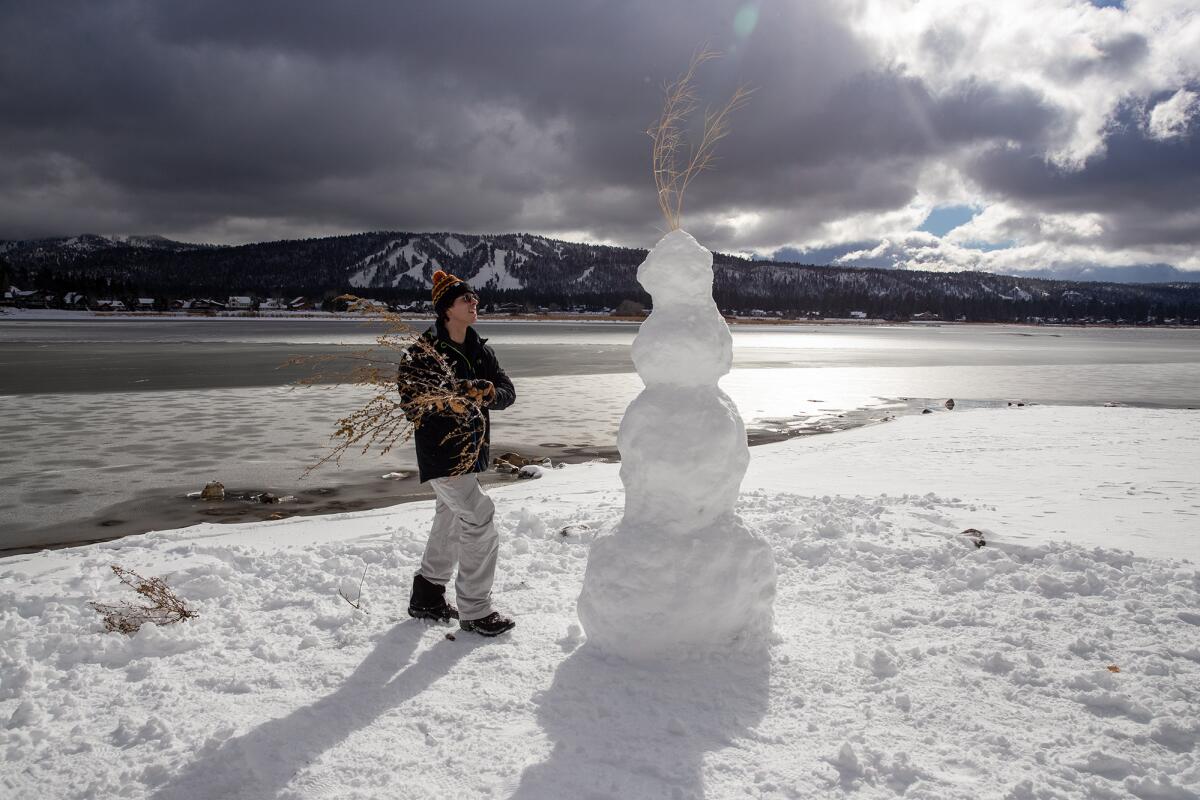
1. Ski or board at Big Bear
Young boarders may head instead for Snow Summit’s sibling two miles away, Bear Mountain ski area (12 chairlifts, 15 trails, including many learner slopes, and 198 skiable acres, including popular terrain parks). Together the two mountains are known as Big Bear Mountain Resort, and lift tickets are interchangeable. Thanks to some early snow (and plenty of snowmaking), the resort opened its 2022 season on Nov. 12.
If you’re going to attempt to ski and surf in one day, you might start or end at Snow Valley (12 lifts, 32 trails, 240 skiable acres) in nearby Running Springs, 10 miles closer to the coast than Snow Summit and Bear Mountain. (For more on California winter resorts, including Mountain High and Mt. Baldy in the San Gabriel Mountains, visit onthesnow.com.)
Don’t forget the rest of Greater Big Bear. Big Bear Lake is the neighborhood’s biggest body of water (with lots of fishing and boating in summer) neighbored by the city of Big Bear Lake and unincorporated area of Big Bear City. A variety of lodgings awaits, from the mountain modernity of Midnight Moon Cabins to your basic Motel 6.
Also: Need a mountain breakfast? Grizzly Manor (7 a.m. to 2 p.m. daily) in Big Bear Lake is known for big portions and irreverent attitude. Or, to quote the website, “bland food ... salty staff.”
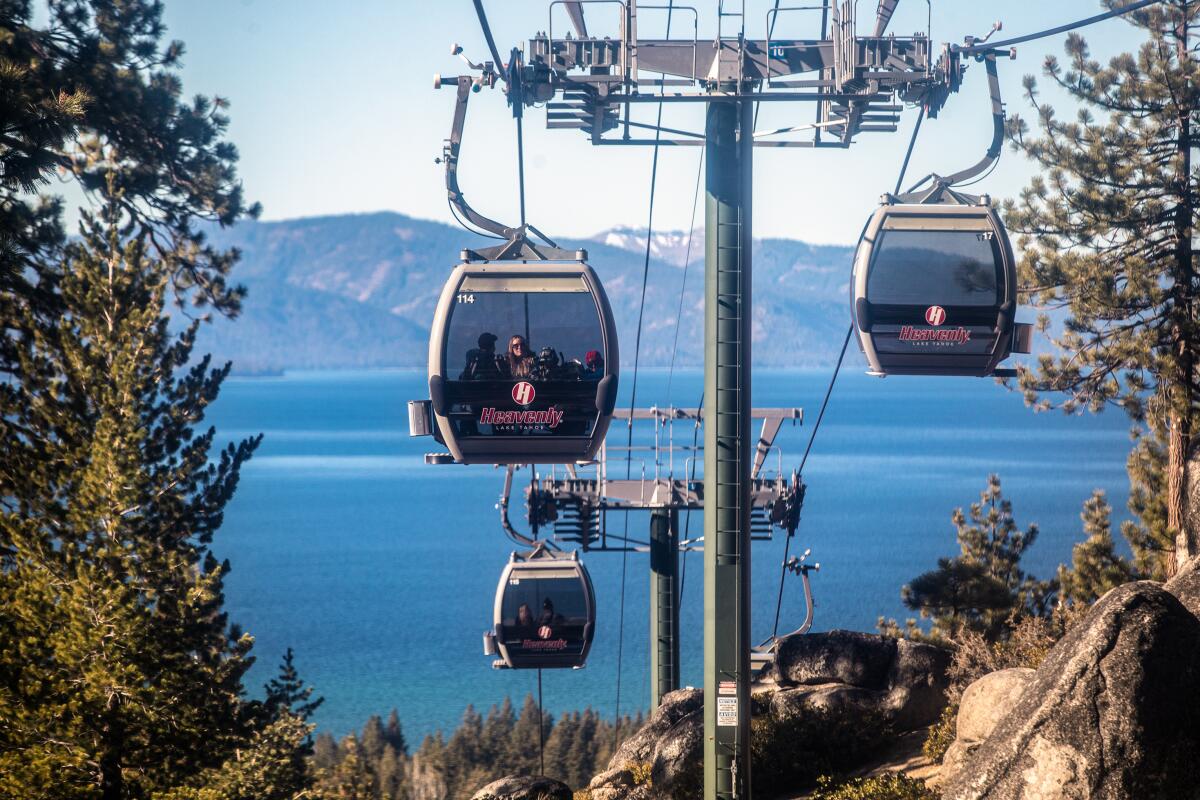
2. Savor Lake Tahoe from Heavenly Ski Resort's slopes
Heavenly’s Scenic Gondola carries skiers between the Heavenly Village and the slopes (which cross the state line into Nevada). The casinos of Stateline, Nevada, begin just across the street from Heavenly Village. Dozens of mom-and-pop hotels and other businesses congregate around the village near Lake Tahoe’s southern shore.
The resort, which goes back to 1955, includes 116 trails and 4,800 skiable acres. It has terrain parks and a skating rink, too.
Among the village restaurants, I liked Azul Latin Kitchen (especially the tacos). For something more casual? Base Camp Pizza offers up pies with barbecued chicken, pears and pineapple.
Instead of arguing over whether pineapple should ever be permitted on pizza, take a minute to remember that the 2021 Caldor fire missed this lake-adjacent resort by just a few miles. If you arrive by car via Highway 395, you’ll see little fire damage en route. If you come in by Highway 50 (as many visitors from Sacramento and San Francisco do), you’re likely to see plenty of scarred slopes. You’ll also see the one Tahoe resort that the Caldor fire did seriously damage — the now-recovered Sierra-at-Tahoe, whose 2022-2023 season is well underway. For details on all California ski areas, check snowpak.com, onthesnow.com or skicalifornia.org.
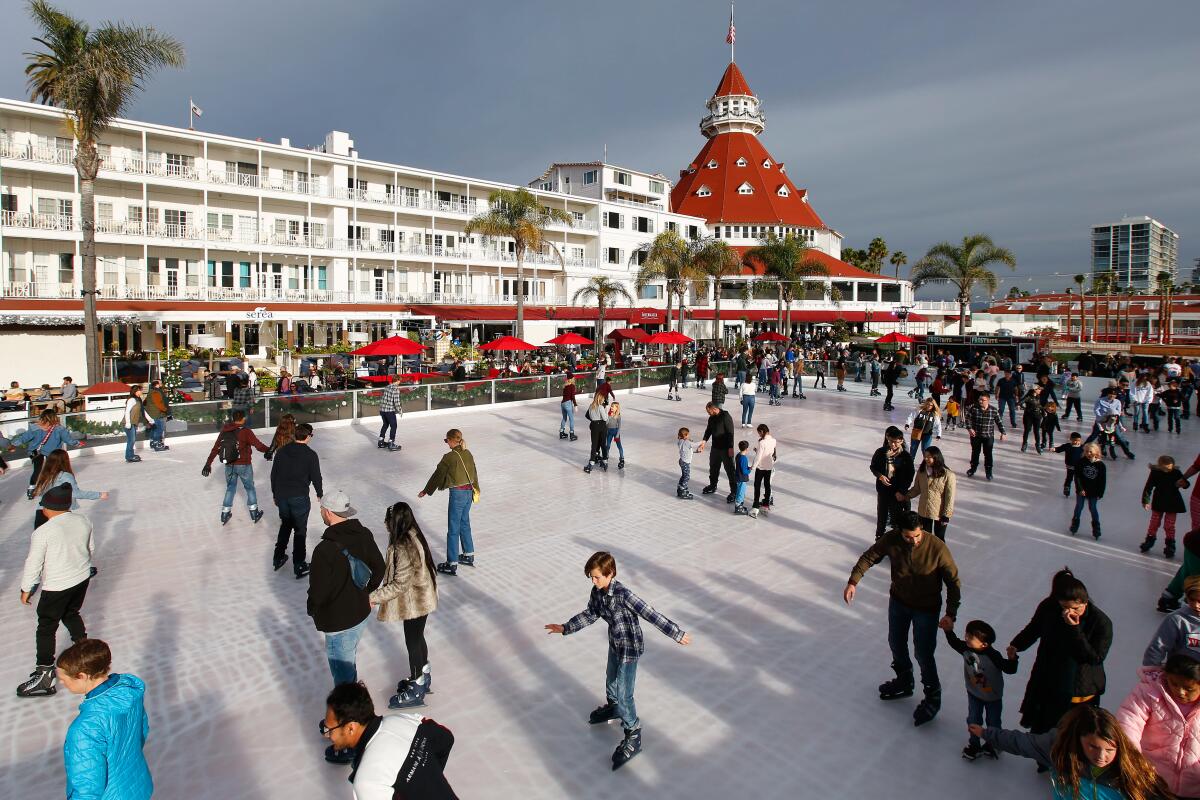
3. Glide around the Hotel Del Coronado skating rink
You do — if you head to the Hotel Del Coronado’s Skating by the Sea. The resort’s seasonal rink is open through Jan. 1 ($40 for up to 90 minutes, skate rental included), and as long as you’re popping by, take a look at the hotel’s lobby, where a two-story Christmas tree is customary. After dark, you’ll catch thousands of holiday lights aglow on the landmark’s iconic red turrets (which date back to 1888).
For my money, there’s no grander old resort, and no older grand resort, in California. Rates usually start around $600 night. (For what it’s worth, staying overnight will get you $5 off on the skating rink.) The hotel has spent many millions on renovations and expansions in the last few years.
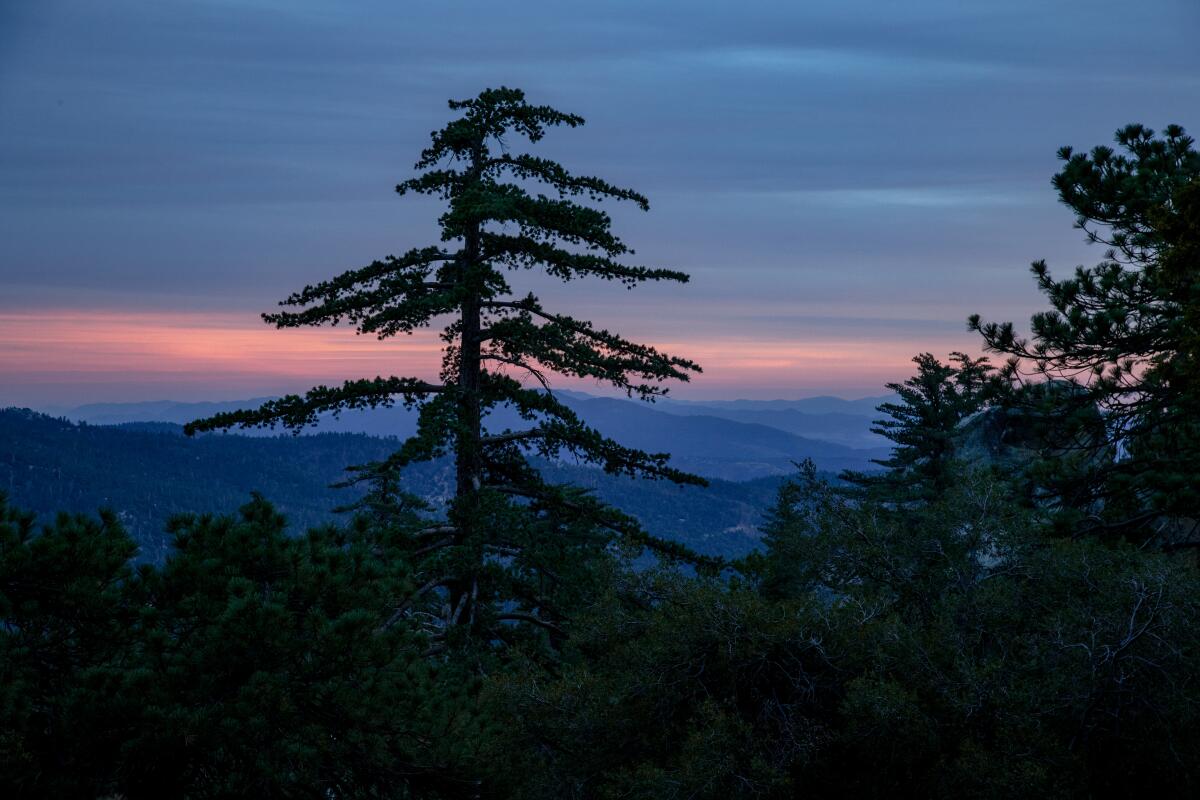
4. Get cozy in Idyllwild
What ever your motivation, it’s a great escape from life in the flatlands.
The town sits about 5,400 feet above sea level, attracting city folk to its inns, vacation rentals and casual eateries. For hiking, snow play, climbing or camping, the Idyllwild Nature Center (open Wednesday through Sunday, about 1 mile northwest of town) is one place to start. Mt. San Jacinto State Park begins at the edge of town, and Idyllwild Regional Park has five trails and 88 campsites on its 202 acres.
Need food and caffeine? Cafe Aroma is an easygoing eatery with lots of sheltered patio seats. The Candy Cupboard has been offering caramel apples, taffy, chocolate, shave ice and other essentials since 1981.
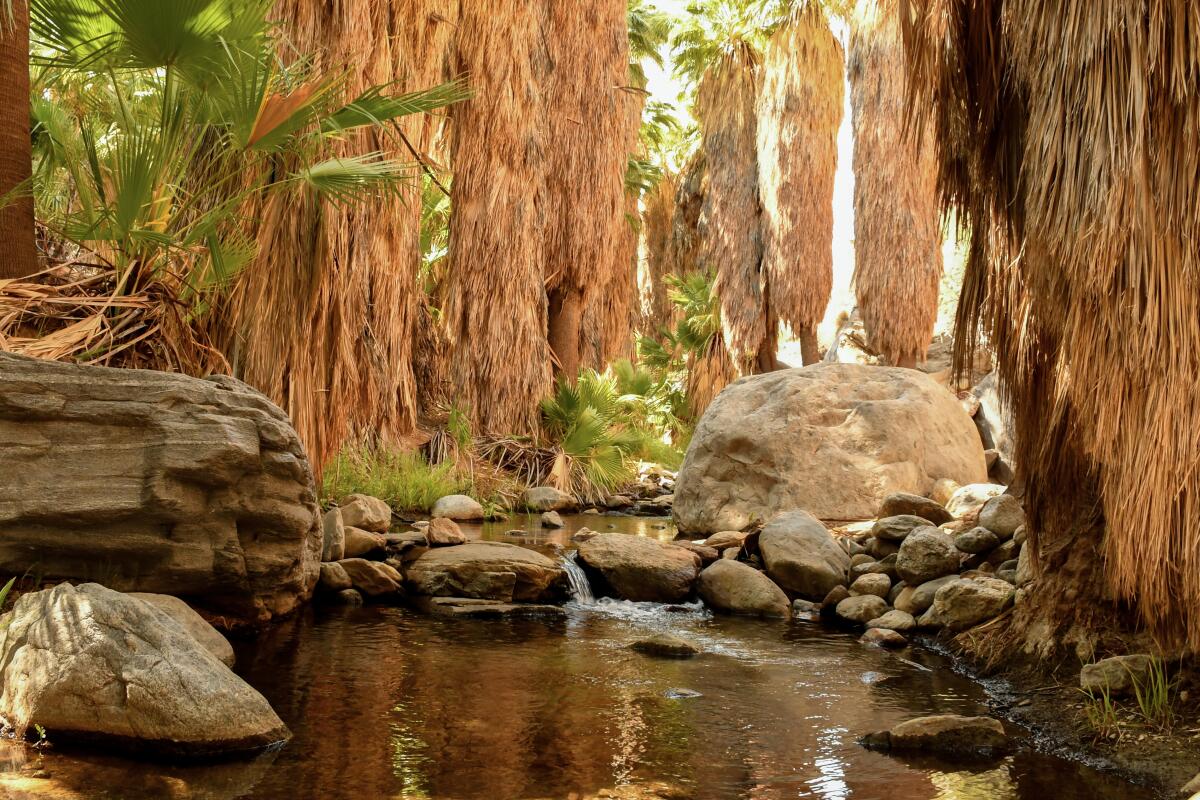
5. Explore the Indian Canyons near Palm Springs
In Andreas Canyon, you follow a path along the year-round Andreas Creek, which is lined by Washingtonia filifera, the California fan palm. This is a genuine oasis, reached by an easy hike — a 1.2-mile round trip.
In Palm Canyon, a few miles away, the looping (and more demanding) 2.7-mile Victor Trail drops into a shady, boulder-strewn fold in the desert hills where more native palms congregate, then returns along a higher ridge. There’s a “trading post” gift shop at the trailhead.
Those canyons, along with Murray Canyon and Tahquitz Canyon (which has a 60-foot seasonal waterfall), are all part of the Indian Canyons network of open space managed (and named) by Agua Caliente leaders.
“I look at this place like a cathedral,” tribal junior ranger Raven Longbow once told me at Palm Canyon.
While you’re in any of the canyons, keep an eye out for desert bighorn sheep (on the slopes above) and rattlesnakes (underfoot). Also, bring a good map and plenty of water. Adult admission to Palm, Andreas and Murray canyons is $12. For Tahquitz Canyon, $15. No pets allowed. Ranger talks and ranger-led hikes offered October-June. Canyons closed to visitors Mondays-Thursdays from July 5- Sept. 30.
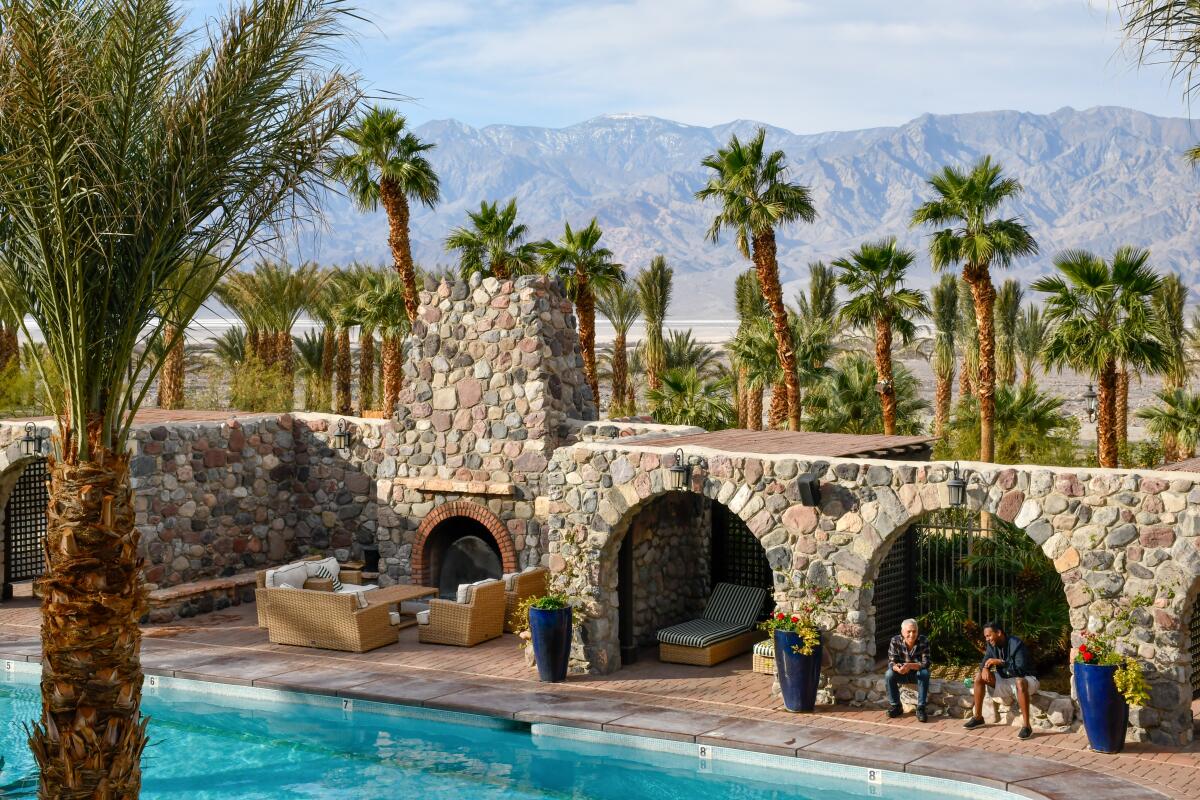
7. Swim at the Inn at Death Valley
The hotel, once known as the Inn at Furnace Creek, typically closes in summer. It includes 66 rooms in the main part of the inn, plus 22 casitas, which are roomier (all at least 500 square feet), more private and come with use of a golf cart. Rates these days start at around $350 nightly for rooms, $540 for casitas.
Not ready for that big a splurge? That’s understandable. Have a look at the inn’s sibling, the Ranch at Death Valley just 1.3 miles away. It’s a more basic, family-friendly hotel with 224 rooms and 80 one-bedroom cottages, neighbored by a restaurant, saloon, ice cream shop, store, pool (again, 87 degrees) and the Furnace Creek Golf Course, where your score is guaranteed to be below sea level. Room rates start at about $180.
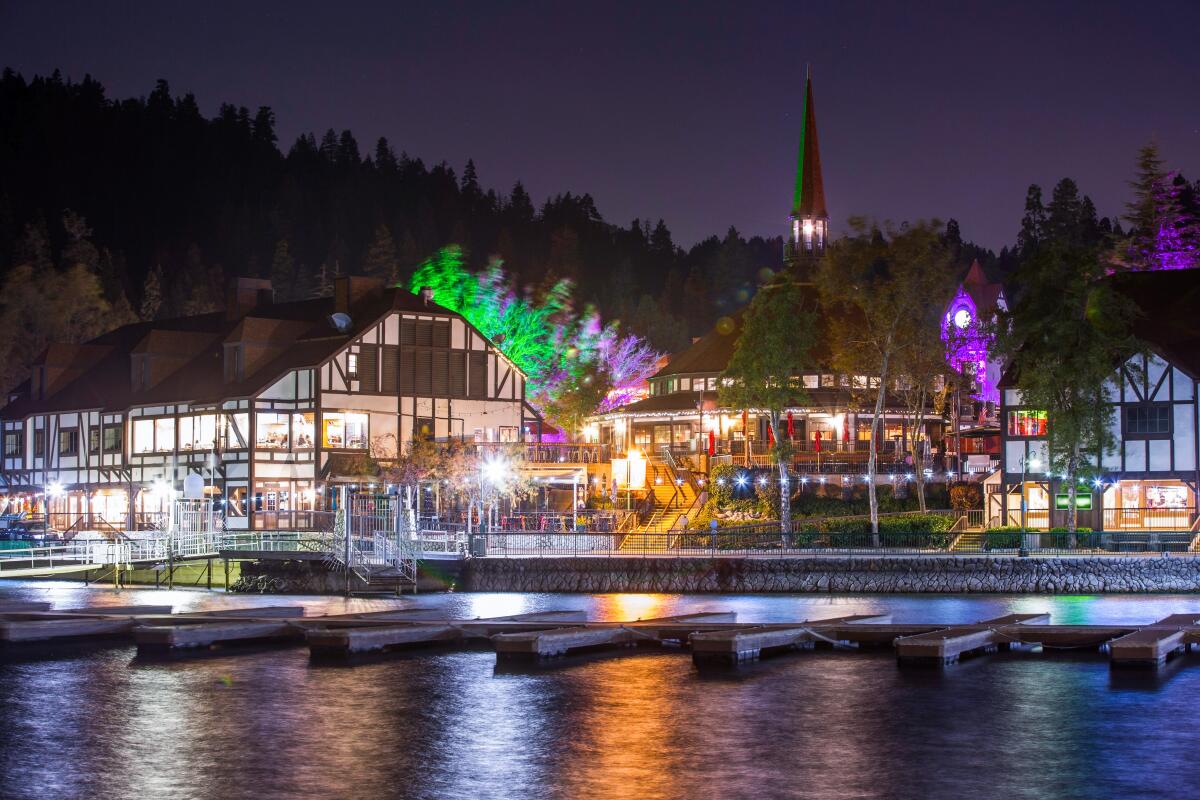
8. Embrace peace and quiet at Lake Arrowhead
For one thing, the lake is privately owned, which means the only people allowed to put boats on it are Arrowhead Woods homeowners and their guests. The roughly 8,900 folks who live here tend to be wealthier and quieter than those in Big Bear. But you are about 5,200 feet above sea level, so snow happens.
If you rent a house or book into a local hotel for a few days, your movements probably will revolve around the waterfront Lake Arrowhead Village, a Tudor-style retail compound that dates back to the 1970s and includes about 50 specialty and outlet stores such as Coach and Pendleton. Belgian Waffle Works is a popular breakfast spot.
To see more of the lake, head to LeRoy’s Board Shop (look for the green star on the wall outside) and buy tickets for an hourlong narrated cruise on the 65-passenger Arrowhead Queen ($26.95 per adult, $19.95 per child ages 2-11).
The Lake Arrowhead Resort & Spa has 173 rooms and a private beach on the lake. The more intimate Saddleback Inn, which dates to 1917, offers 14 rooms, 20 cottages and Diane’s Saddleback Grill.
Nearby Skypark at Santa’s Village, about 3 miles south of the lake, is big with families. Day passes through Jan. 8 go for $69 per adult, $59 per child (ages 4-12). Tickets are $10 less if you buy online in advance.
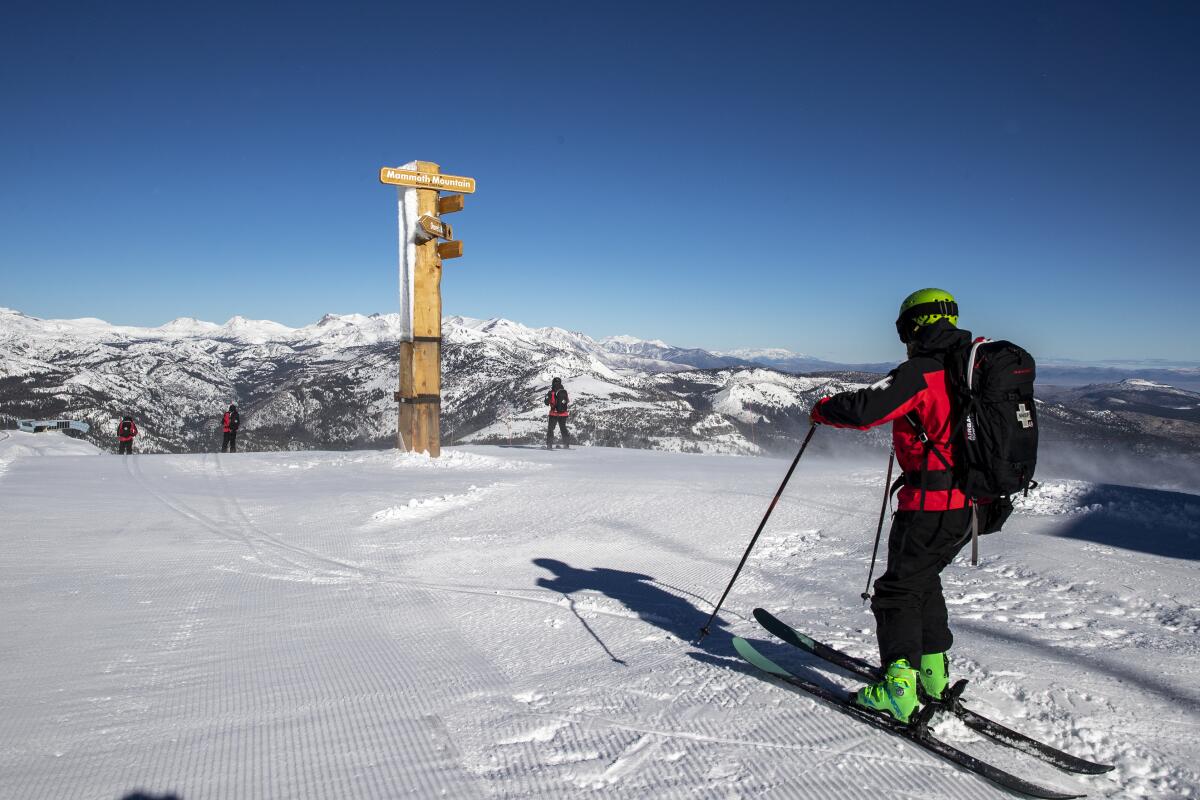
9. Chase winter thrills at Mammoth Mountain
With an altitude that often allows for early opening (Nov. 11 in 2022) and a mountain full of everything from black-diamond runs to welcoming beginner slopes, Mammoth Mountain and the neighboring town, Mammoth Lakes, are a winter habit for legions of skiers and boarders. By Dec. 5, 13 of the mountain’s 25 lifts were running and there was 5 feet of snow on the ground.
The summit (at 11,053 feet) is the highest of any California ski destination. The town (population about 7,300) includes thousands of hotel rooms, condos, B&Bs, rental cabins and homes. Much of the après-ski action happens in the bars and restaurants of The Village, which in January 2023 is due to gain a high-profile Italian restaurant: Vulcania, by chefs Bryan and Michael Voltaggio.
For a more quiet, intimate snow escape, head for Tamarack Lodge, a lakeside log-cabin inn and restaurant with an inviting stone fireplace and cross-country ski center. It’s about a mile from Mammoth Mountain. Built in 1924, it includes 11 guest rooms, 37 cabins and a gourmet restaurant, the Lakefront (dinner only).
The resort includes 25 lifts, 175 trails and 3,500 skiable acres. One-day lift tickets typically cost $169-229 on weekends.
Although most visitors drive up Highway 395 to reach the mountain (310 miles north of L.A. City Hall), this winter through April 4, Advanced Air is offering several public charter flights per week to Mammoth from Hawthorne, Burbank and Carlsbad. Also, on Dec. 19, United begins seasonal daily service between Los Angeles International Airport and Bishop airport, about 50 miles southeast of Mammoth.
For details and updates on the slopes at Mammoth, check snowpak.com, onthesnow.com or skicalifornia.org.
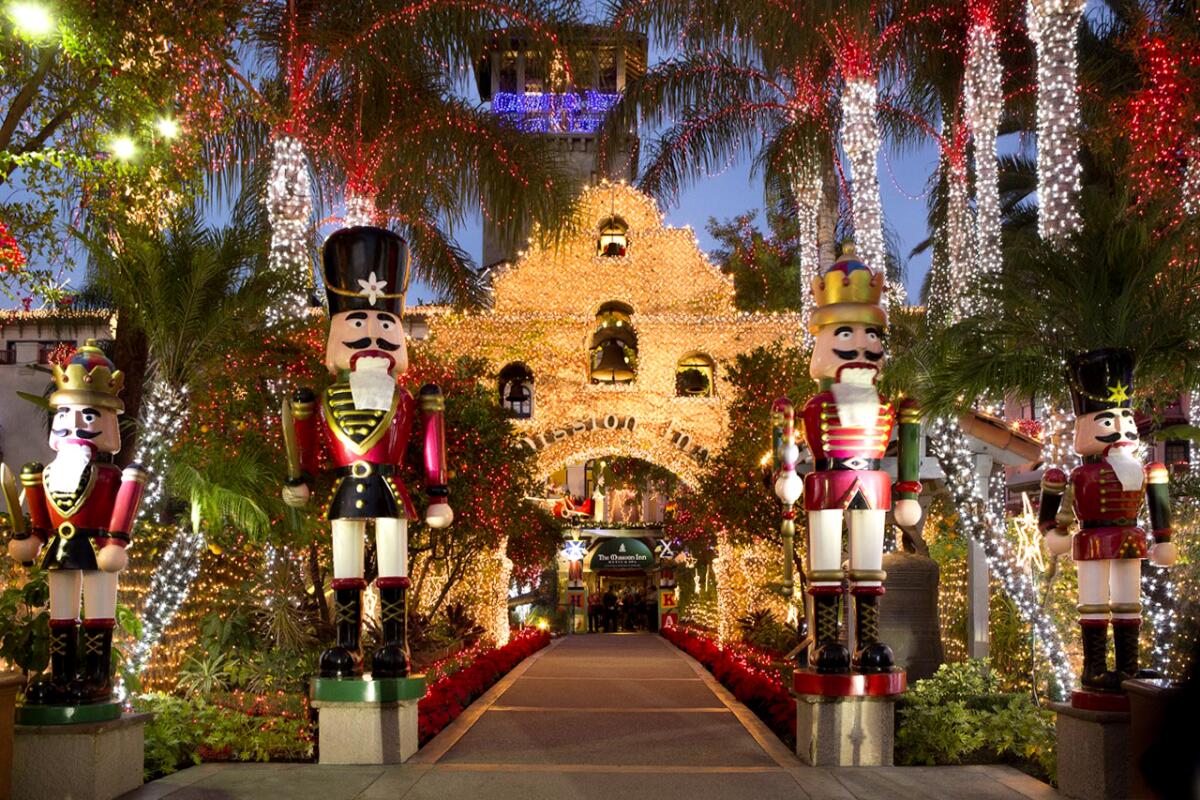
10. Surround yourself with holiday lights at the Mission Inn
For six weeks at Christmastime, the landmark hotel switches on about 5 million lights and invites visitors to stroll for free through the property, including a tunnel where faux snow falls. This winter’s festival runs through Jan. 6, 2023.
The crowds, traffic and parking can be a challenge, however. To skip the line, book the Sunday Christmas Brunch Buffet ($72 per adult), where Santa makes an appearance. Or, any day, book dinner at the Mission Inn Restaurant (main dishes $24-$59) and you may land at a patio table, surrounded by domes, towers, arches and buttresses, augmented for the season by angels, gnomes and polar bears, many of which move like the animatronic President Lincoln in Disneyland. (Overnight stays start at $229.) While you’re there, raise a glass to hotel owners Duane and Kelly Roberts. Duane Roberts is a local boy who made his first fortune selling frozen burritos.
By the way, if you arrived before dark or spend the night, you may have a chance to check out the Cheech Marin Center for Chicano Art & Culture adjacent to the Mission Inn The center, run by the Riverside Art Museum, displays works by artists including Patssi Valdez, Sandy Rodriguez, Carlos Almaraz, Frank Romero and Gilbert “Magú” Luján.
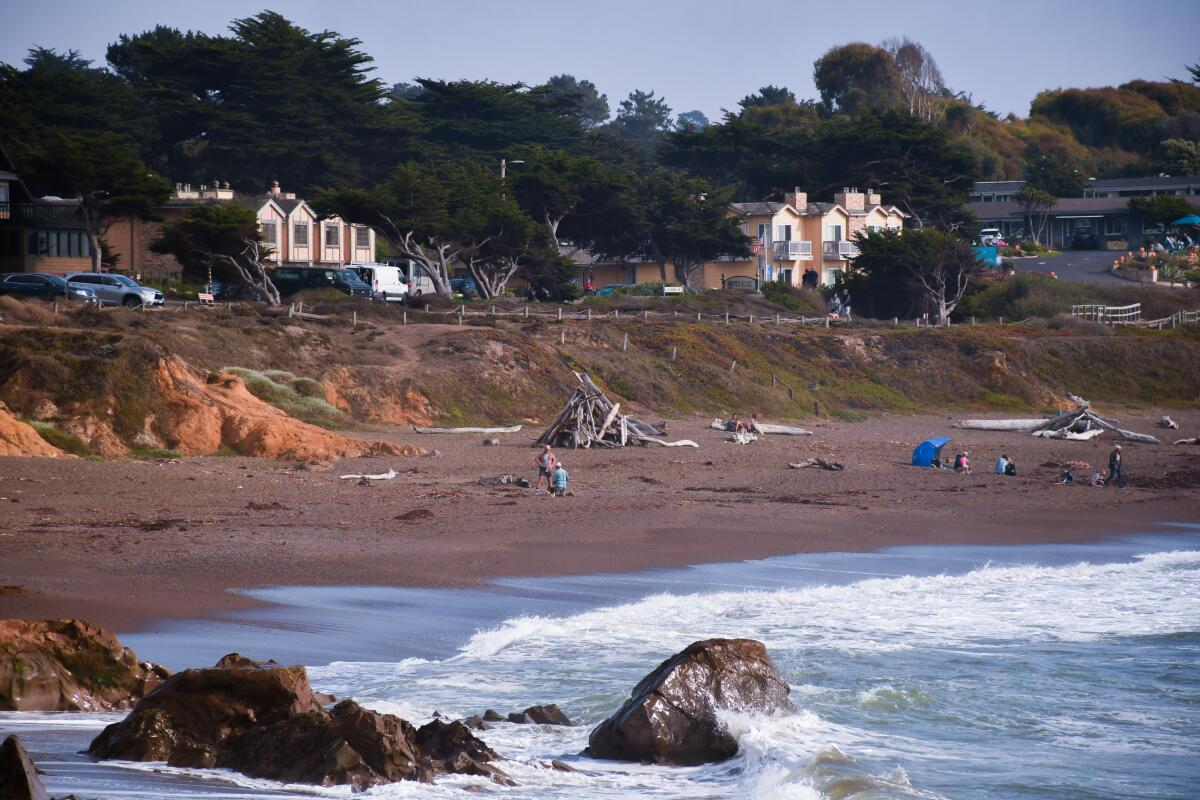
11. Play with driftwood along Moonstone Beach, Cambria
The city’s east and west villages sit a bit inland, and Main Street includes art galleries and boutiques but no chain stores.
Stroll the mile-long Moonstone Beach Boardwalk. Hike on the Fiscalini Ranch Preserve‘s Bluff Trail. Hop down to the beach and start rearranging driftwood.
Sample the eclectic menu at Robin’s Restaurant (a mainstay for more than 25 years) or dig into olallieberry pie at Linn’s Restaurant. If you’re among those devotees of the cash-only, no-reservations Sea Chest Oyster Bar, remember that the owners close down for a big chunk of December. (In 2022, they are closed Dec. 4-25.) The Cambria Pines Lodge hosts an annual Cambria Christmas Market, with vendors through Dec. 23 and lights through Jan. 1.
Be warned, however, that Cambria has been struggling with water shortages since long before the current drought. If you go, be quick in the shower and frugal with the faucet.
Also, don’t forget that San Simeon is 9 miles up the road. Hearst Castle, open again after an extended closure from 2020-22, offers several tours, including an evening tour for which visitors are invited to dress in ‘30s styles.
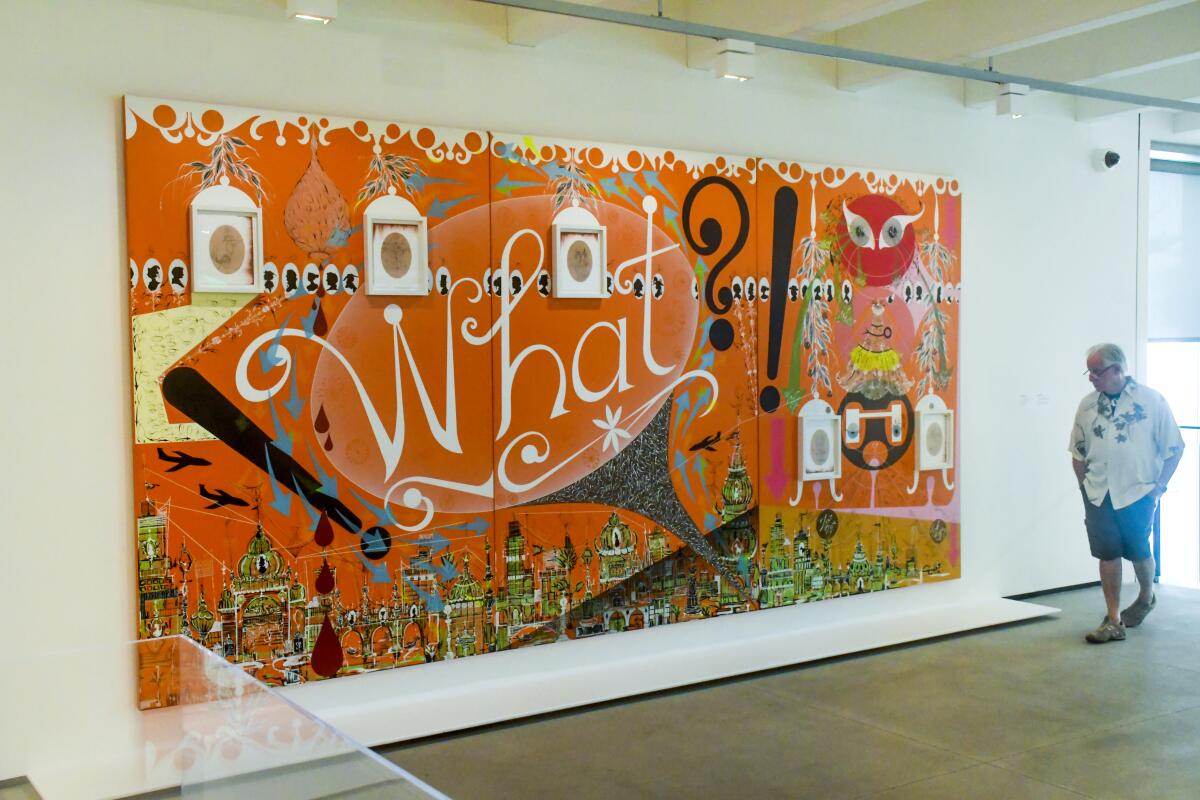
12. Challenge yourself amid the art at MCASD La Jolla
Through Jan. 29, the museum is featuring an Alexis Smith retrospective, full of the artist’ playful takes on pop culture and the American Dream. The MCASD La Jolla site also features several dramatic outdoor works and commanding views of the ocean. Adult admission, $25.
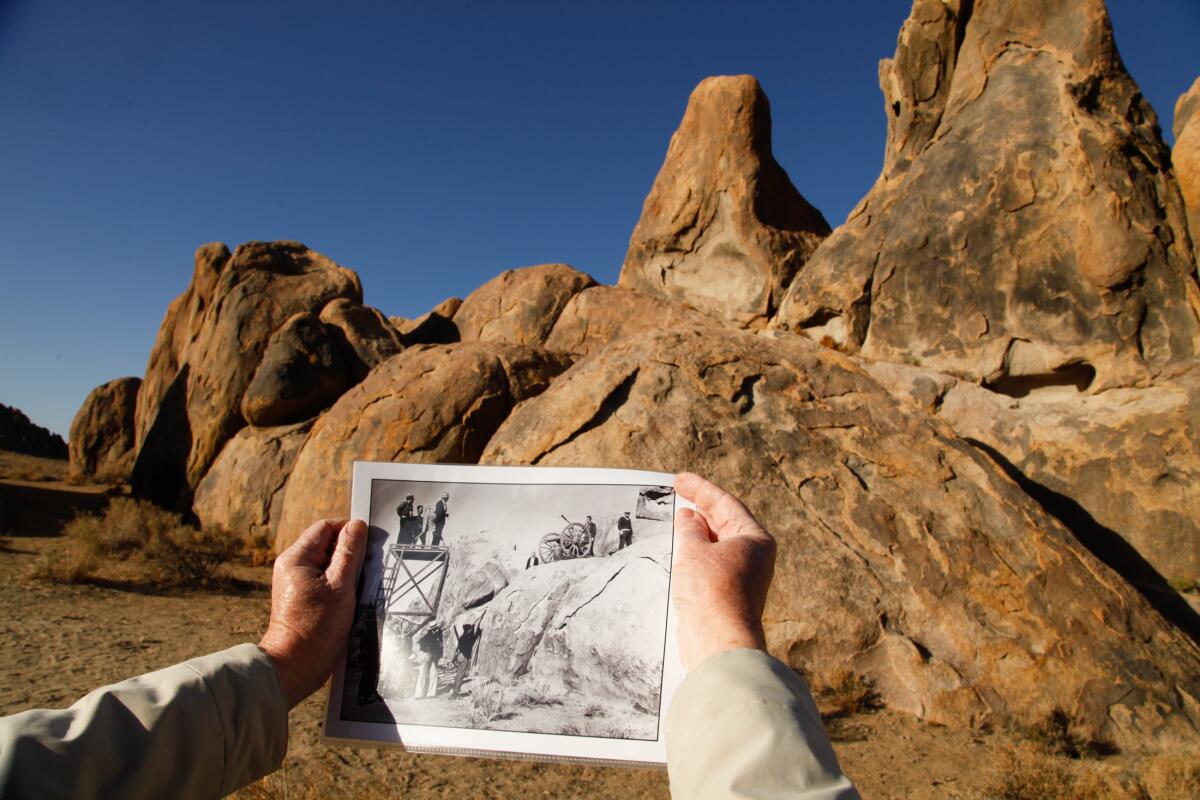
13. Learn about old and new legends at the Museum of Western Film History
You’ll also learn how some 400 movies, myriad TV episodes and 1,000 commercials have been shot in the hills of the Eastern Sierra since 1920, with Mt. Whitney, Mobius Arch and the boulders of the Alabama Hills threatening to steal every scene. The museum, open daily, was born in 2006.
Your second stop is the Alabama Hills themselves, which begin about two miles west of the museum. Using a map from the museum, you can drive Movie Road and walk Lone Ranger Canyon, scanning the strangely familiar landscape and reviewing the list of titles filmed there, including parts of the “Iron Man,” “Star Trek” and “Star Wars” franchises.
The museum stages a three-day Lone Pine Film Festival every October, screening films shot in the area. The event includes location tours, panel discussions, interviews and a parade on Main Street.
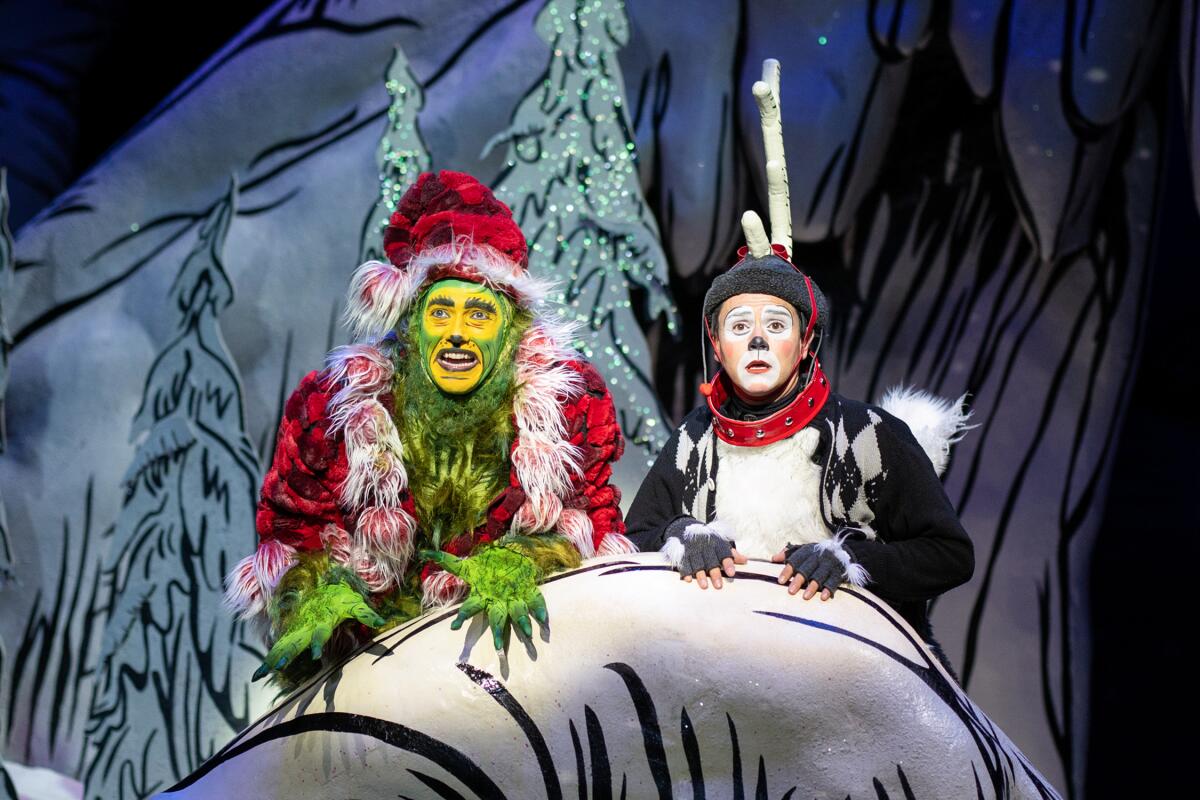
14. See a play at the Old Globe in San Diego
“Dr. Seuss’s How the Grinch Stole Christmas!” runs through Dec. 31. (If you’re bringing a child under age 3, be sure to sign up for a 10:30 a.m. performance.) The Globe treasures a deep and longstanding connection with the Grinch, whose creator, Dr. Seuss (a.k.a. Ted Geisel), lived in La Jolla for about 40 years.
Also, “Ebenezer Scrooge’s BIG San Diego Christmas Show” runs through Dec. 24. On Jan. 21, as the theater turns from the holidays to fresher material, comes “The Notebooks of Leonardo da Vinci,” adapted and directed by Mary Zimmerman.
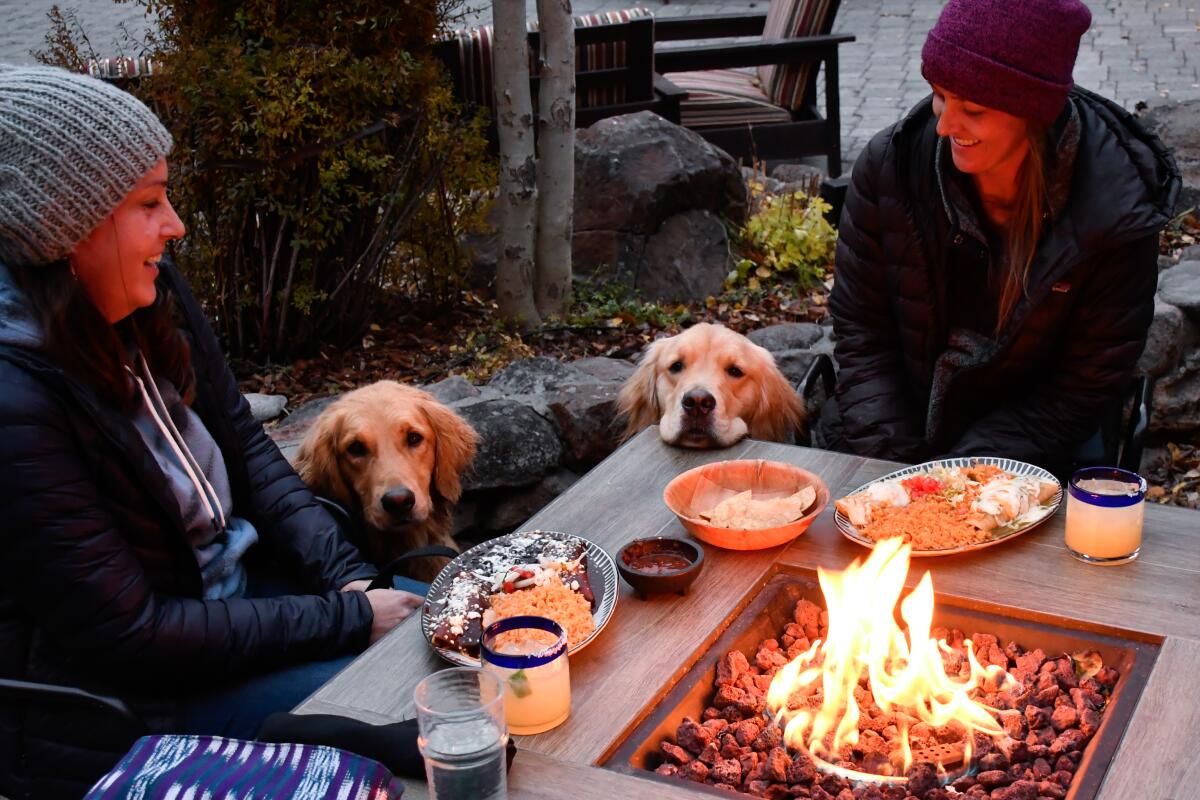
15. Try the new gondola at Palisades Tahoe
Palisades Tahoe (which was known as Squaw Valley until September of 2021) is the biggest ski resort in the state, a realm of two mountains, freshly tethered together.
One mountain is Olympic Valley, with 29 lifts, 170 trails, nearly 3,600 skiable acres, five terrain parks and proud history as the site of the 1960 Olympics. But never mind that. Just look at the way its aerial tram dangles above a majestic, forbidding pile of boulders known as Tram Face.
The second mountain is the Alpine Meadows area (13 lifts, 100 trails and 2,400 skiable acres). Because of its location, locals say it has the longest potential ski season of any local resort.
The tether between Olympic Valley and Alpine Meadows is the new Base to Base Gondola, opening Dec. 17. It’s a 17-minute gondola ride for skiers and boarders to transit between mountains, or a 7-mile drive if you’re stuck in an old-fashioned automobile.
By Dec. 5, Palisades had eight chairlifts running, including its aerial tram, which offers a 10-mine, $54-per-adult ride to the resort’s HighCamp, 8,200 feet above sea level. For skiers’ details on California slopes, check snowpak.com, onthesnow.com or skicalifornia.org.
When you get hungry: In the Village at Palisades Tahoe, you’ll get hearty portions at Tremigo Mexican Kitchen (where I loved my carne asada but couldn’t finish it) and Guinness on tap at the Auld Dubliner a few steps away. PlumpJack Cafe (fine dining, opening Dec. 8) is handy as well.
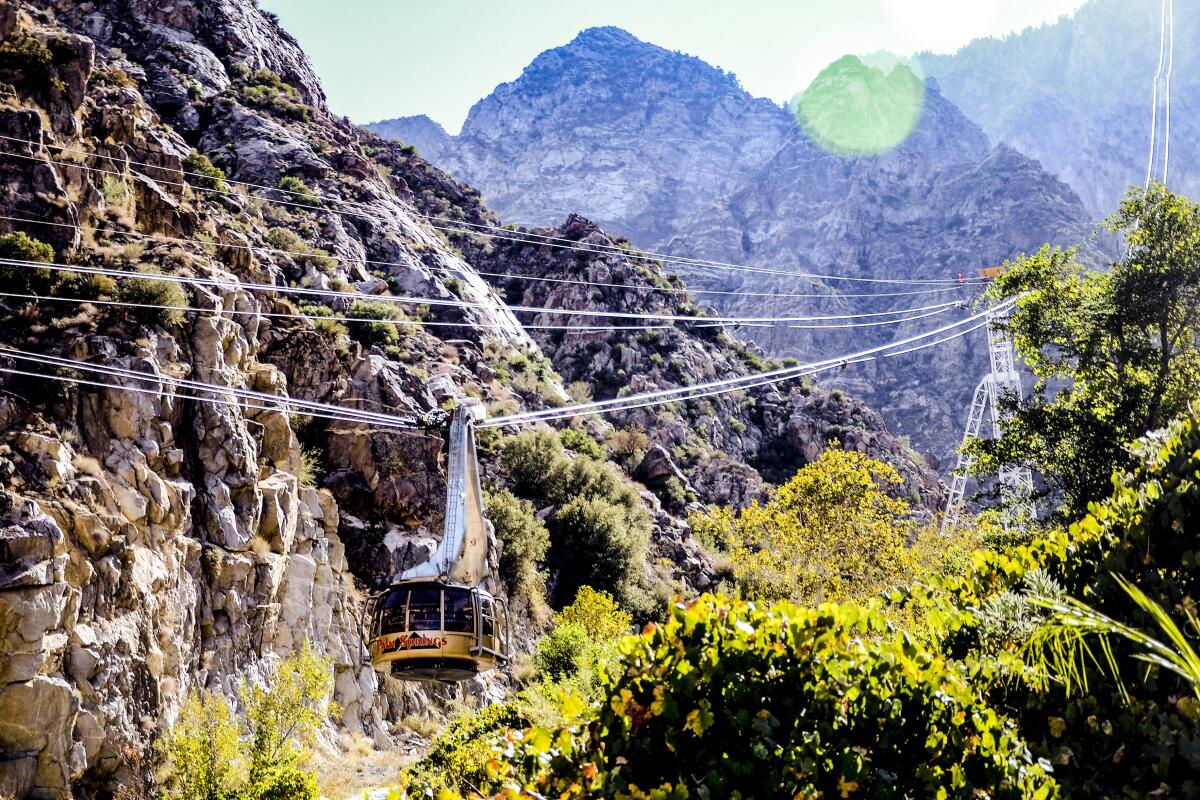
16. Ride into the sky on the Palm Springs Aerial Tramway
Back in 1935, a man named Francis Crocker proposed a tram ride to connect the Coachella Valley desert floor to the upper slopes of Mt. San Jacinto. Twenty-eight years later, the Palm Springs Aerial Tramway opened.
After parking ($10), you step into Valley Station (elevation 2,643 feet), pay $28.95 (standard adult fare) and board the gondola, having made sure that there’s snow up high.
Then you begin the climb up Chino Canyon in a slowly rotating gondola (apparently the world’s largest rotating tram car) with a capacity of 80 passengers. It’s a 2.5-mile trip to Mountain Station (elevation 8,516 feet), where it’s typically 30 to 40 degrees cooler than at Valley Station. On the way, there’s ventilation through the open tram windows.
On weekends the trams start at 8 a.m. On weekdays, 10 a.m.
The last tram up leaves at 8 p.m., so there’s plenty of time to catch sunset. There are a couple of restaurants at the top: Peaks is fancy and open for lunch and dinner. Pines is a cafeteria open from 8 a.m. to 8:30 p.m. on weekends, 10 a.m.- 8:30 p.m. on weekdays. The Lookout Lounge, also up top, serves beer, wine and cocktails until 8:30 p.m.
Once there’s a good amount of snow, the Mountain Station-adjacent Winter Adventure Center will open, offering rental snowshoes and cross-country skis. Call or consult the website to check the Adventure Center status.
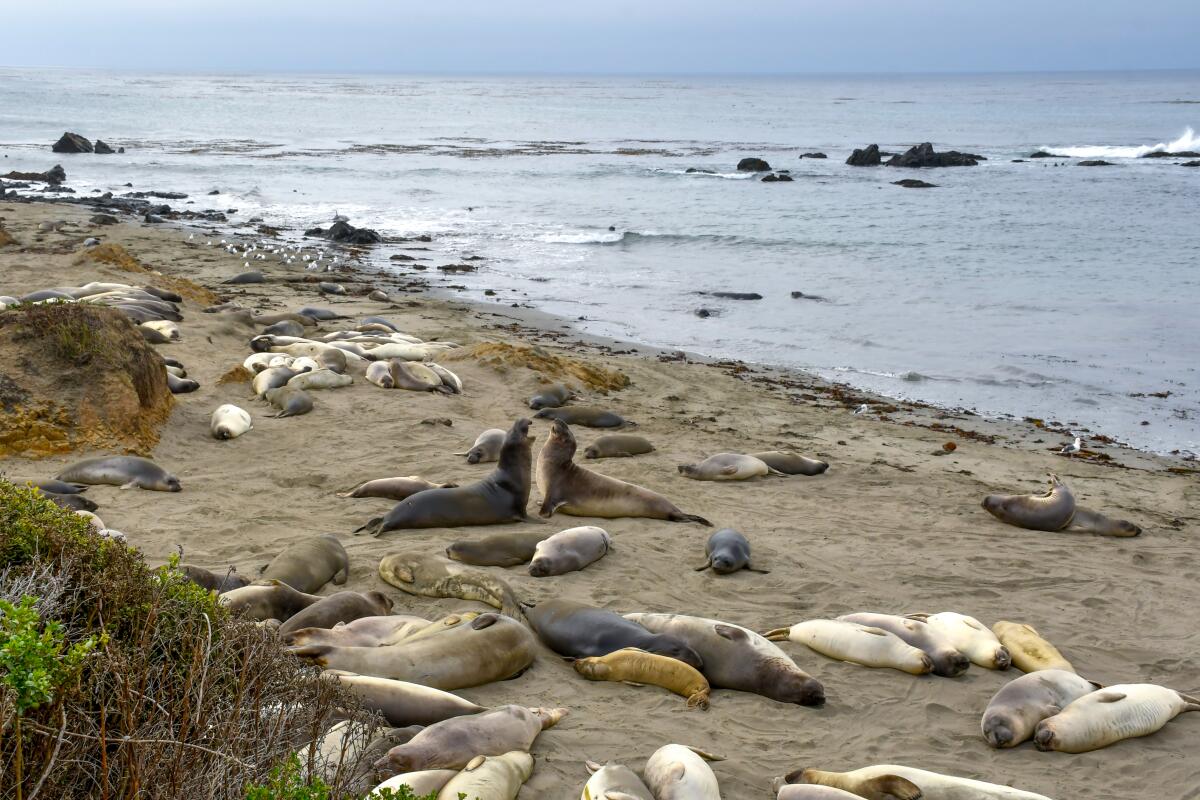
17. Watch beached beasts at Piedras Blancas Elephant Seal Rookery
So, of course, you want to see them. And winter is prime time at Piedras Blancas, where hundreds of these seals at a time bask, spar, give birth and mate on a ridiculously beautiful stretch of state-controlled undeveloped coastline 7 miles north of San Simeon.
It’s free and open every day. There’s a parking lot and boardwalk (wheelchair accessible), usually patrolled by a few volunteer docents in blue windbreakers. You watch and listen, walk the pathway and (as the National Park Service urges) stay at least 25 feet away from the hulking beasts. Keep dogs and drones away altogether.
They’re called elephant seals because of the large proboscis grown by the adult males (which get up to 18 feet long and 5,000 pounds).
In November, thousands of the males begin showing up after months in the open ocean, to skirmish over dominance. In December, pregnant females start gathering in “harems” around dominant males. In January and February they typically give birth, followed by the resumption of mating a few weeks later.
In March, the adult males are the first to leave, having lost up to 40% of their body weight in fasting, fighting and fornicating. Females and weanlings leave later, but the animals come back to molt in spring and summer.
Elephant seals also are common at Año Nuevo State Park in Santa Cruz County and Point Reyes in Marin County.
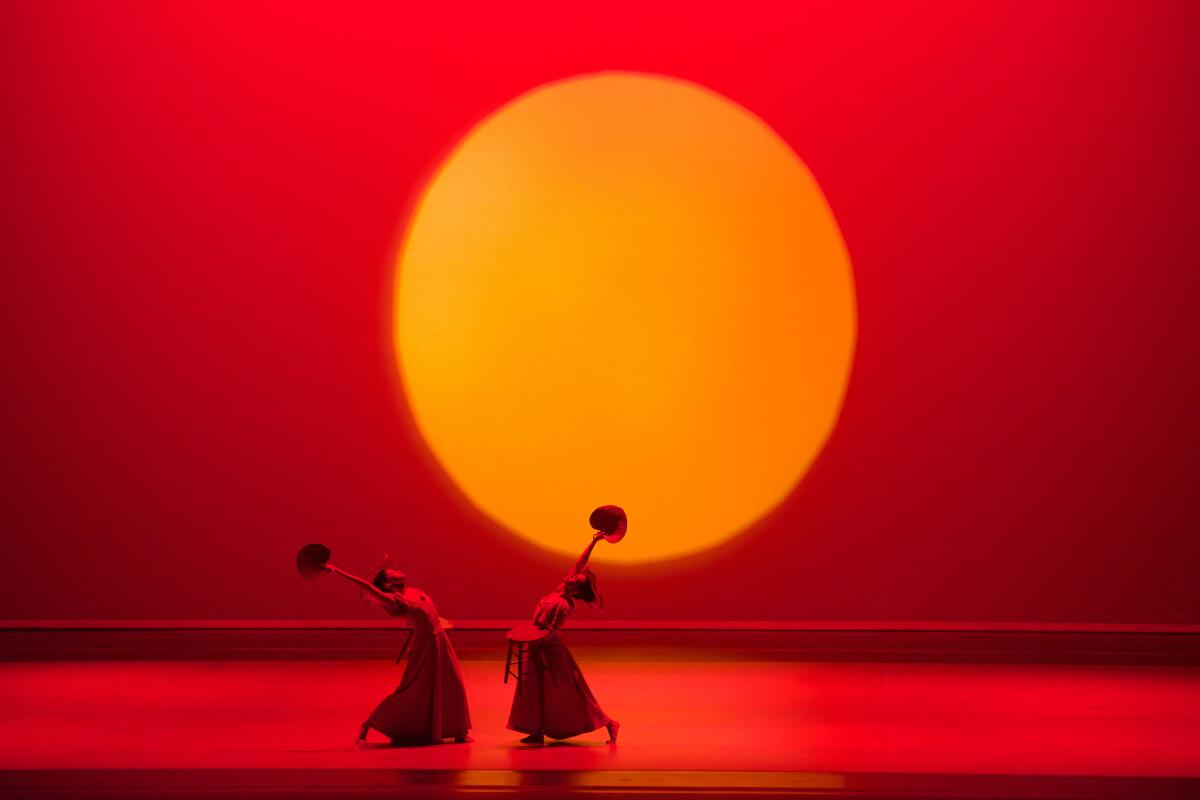
18. Catch a show at the Segerstrom Center for the Arts
But this time you’re coming for culture. Just across Bristol Street from the mall, you’ll find Segerstrom Center for the Arts, whose several venues have holiday offerings, including “The Nutcracker” (American Ballet Theatre, Dec. 9-18), the Manhattan Transfer singing holiday pops (Dec. 16-17) and a Dec. 23 Christmas concert by Johnny Mathis (who is 87). A traveling production of Disney’s “Frozen” musical is due in Feb. 1-19 at the campus’s largest venue, 3,000-seat Segerstrom Hall.
Meanwhile, South Coast Repertory Theater, also on campus and back to live shows, is offering a full December of “A Christmas Carol” as part of its 2022-23 season.
Also, the Orange County Museum of Art, formerly of Newport Beach, has opened its long-awaited new main building at Segerstrom Center in fall 2022. Admission is free.
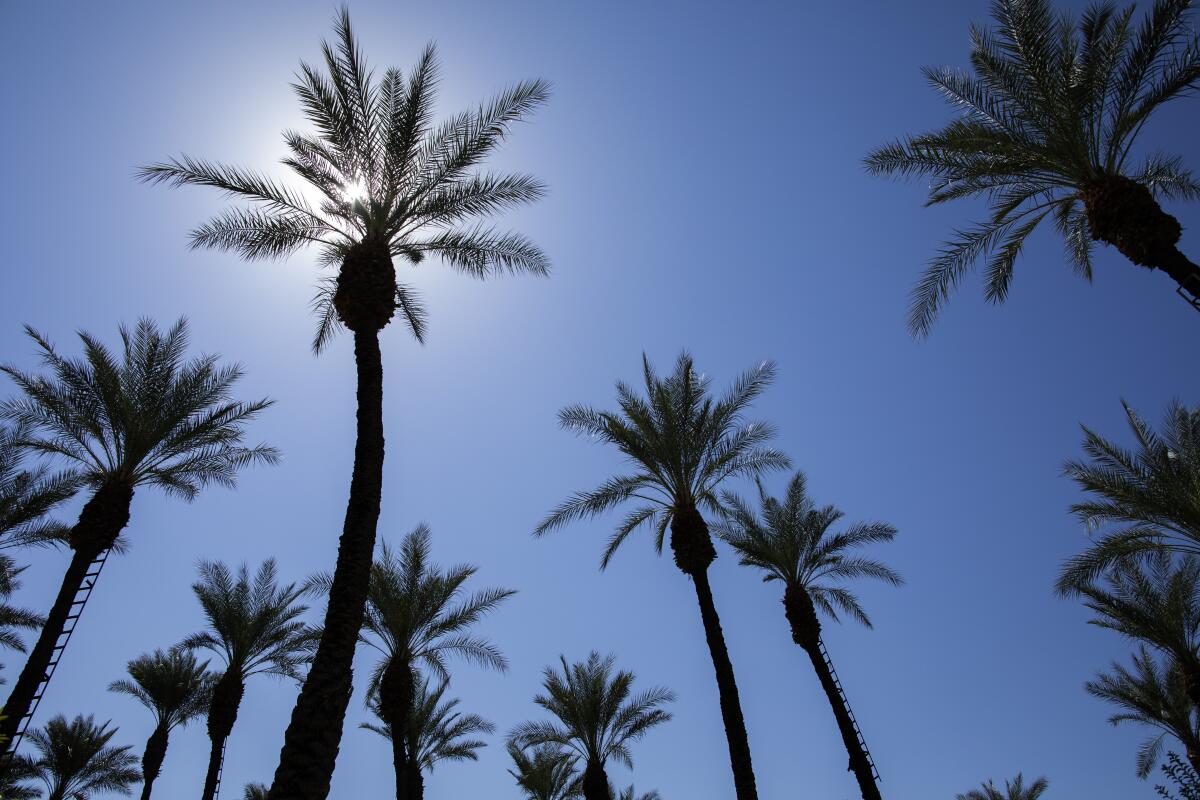
19. Slurp a date shake at Shields in Indio
This combination keeps the place remarkably busy, including its old fashioned shake counter ($7.95 for 21 ounces of cool desert sweetness); its retail shop; its sprawling outdoor café; and the 105-seat theater which screens a slide show daily on “The Romance and Sex Life of the Date.” The slide show (which explains the subtle points of date palm cultivation) goes back to the early 1950s, when co-founder Floyd Shields was looking for a new way to lure more visitors.
These days, the slide show vies for visitors with The Walk, a path through the palms to statuary illustrating 14 scenes from the life of Christ. The statuary arrived about 10 years ago, having been relocated from a biblical garden in Vancouver, British Columbia. The fee for strolling The Walk is $5 per adult, children 12 and under free.
Besides shakes, The Cafe at Shields offers homemade tamales, beer, mimosas, chavelas, chicken and waffles, many fruity snacks (date butter, date jam, date cake, date syrup, date crystal-infused coffee…) and many vegetarian and gluten-free options. It serves breakfast and lunch, 8 a.m. to 2 p.m. daily. Shields also plans to open a Knight’s Brew Coffee Shop in 2023.
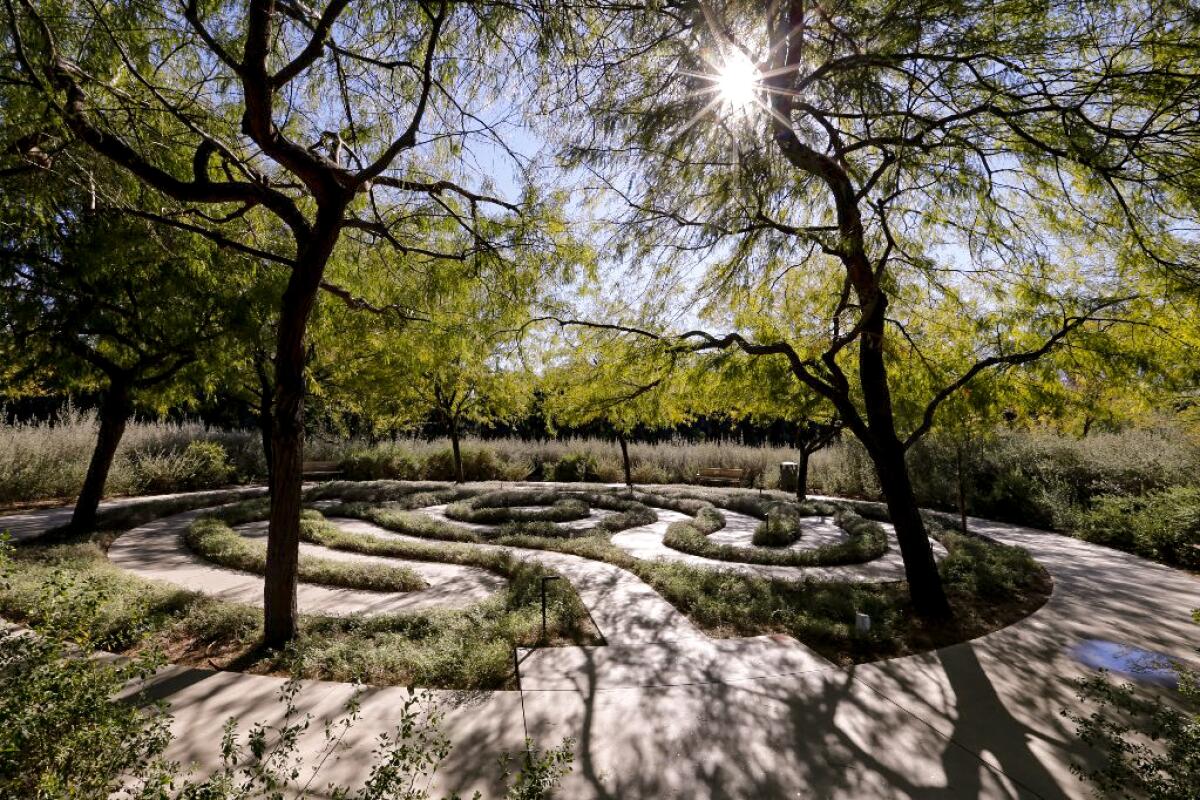
20. Inspect Sunnylands, a unique desert mansion
You could think of it simply as a sleek, vast estate, but I think of it as the White House of Midcentury Modernism. It was the winter playground of Walter and Leonore Annenberg, whose holdings included the once vastly powerful publication TV Guide. Walter Annenberg served as an ambassador for former President Richard Nixon. Leonore Annenberg oversaw protocol for former President Ronald Reagan. They commissioned architect A. Quincy Jones and built the estate (200 acres, 11 lakes) in 1966.
In 2012, after their deaths, the Annenberg Foundation opened the 15-acre Sunnylands Center and its succulent gardens, including a gift shop and reflecting pools, to free public visits, Wednesdays through Sundays, 8:30 a.m. to 4 p.m. (but closed on Thanksgiving, Christmas and New Year’s Day).
Grab lunch from the cafe, sit back on the patio and imagine you’re Frank Sinatra on the brink of his fourth marriage. (Yes, that happened here in 1976. The bride was Barbara Marx, Zeppo’s ex.)
You can tour the rest of the estate too, but you’ll need to buy a timed ticket. Reservations go fast, and the property closes in summer months. There’s a $55 house tour (90 minutes, seven guests to a tour, 25,000 square feet of indoor space to cover). Other tours include one for birders, a 1-mile historic walk and a 45-minute open-air shuttle (golf cart) ride around the 200-acre estate. Most tours are offered November through April.
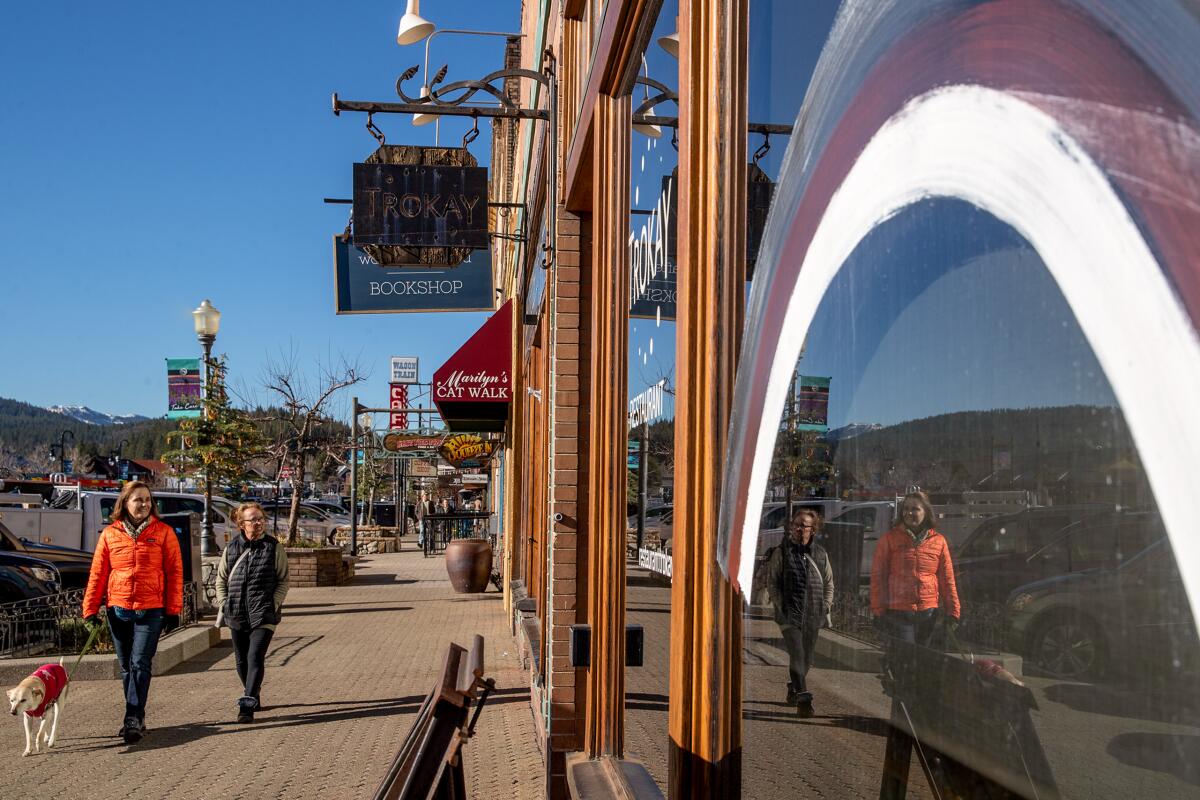
21. Stroll downtown Truckee, near Tahoe
You can’t blame them. Truckee, 12 miles northwest of Lake Tahoe, about 5,800 feet above sea level and handy to several ski resorts, is a fine place to take a day off from skiing (in winter) or from lake sports in (summer) to hike along the Truckee River (which runs through town) or patrol the sidewalks of Donner Pass Road, checking out restaurants, bars, boutiques, galleries and a pretty good bookstore (Word After Word).
Just 3 miles west of town, you’ll find Donner Lake and Donner Memorial State Park, where you can hike, camp or picnic, if you don’t mind being reminded of the Donner party’s disastrous winter here in 1846-47.
If you arrive with kids, it may be hard to resist a burger and a shake in Jax at the Tracks, a reconditioned 1948 diner that counts Guy Fieri among its past customers. If you’re seeking a more adult buzz, the bar, restaurant, ski and bike shop RMU Truckee (housed in an 1873 home) has been drawing crowds since opening in December 2021. If you’re spending the night, Gravity Haus Truckee-Tahoe is a remarkable piece of architecture — part cozy cabin, part industrial chic — that’s also home to an admirable restaurant (Stella, whose menu is part Mexican, part Middle Eastern).
There are a few shadows in Truckee’s history, however. One is the Donner Party, whose suffering wasn’t far from here. Also, I never knew, until visiting, of another 19th century disaster here. In the 1870s and ’80s, after hundreds of Chinese railroad workers put down roots in town, members of a local Caucasian league led a community campaign of shootings, fires and boycotts to chase the Chinese away. From a Chinatown that once stretched for blocks, one building (built of brick) remains.
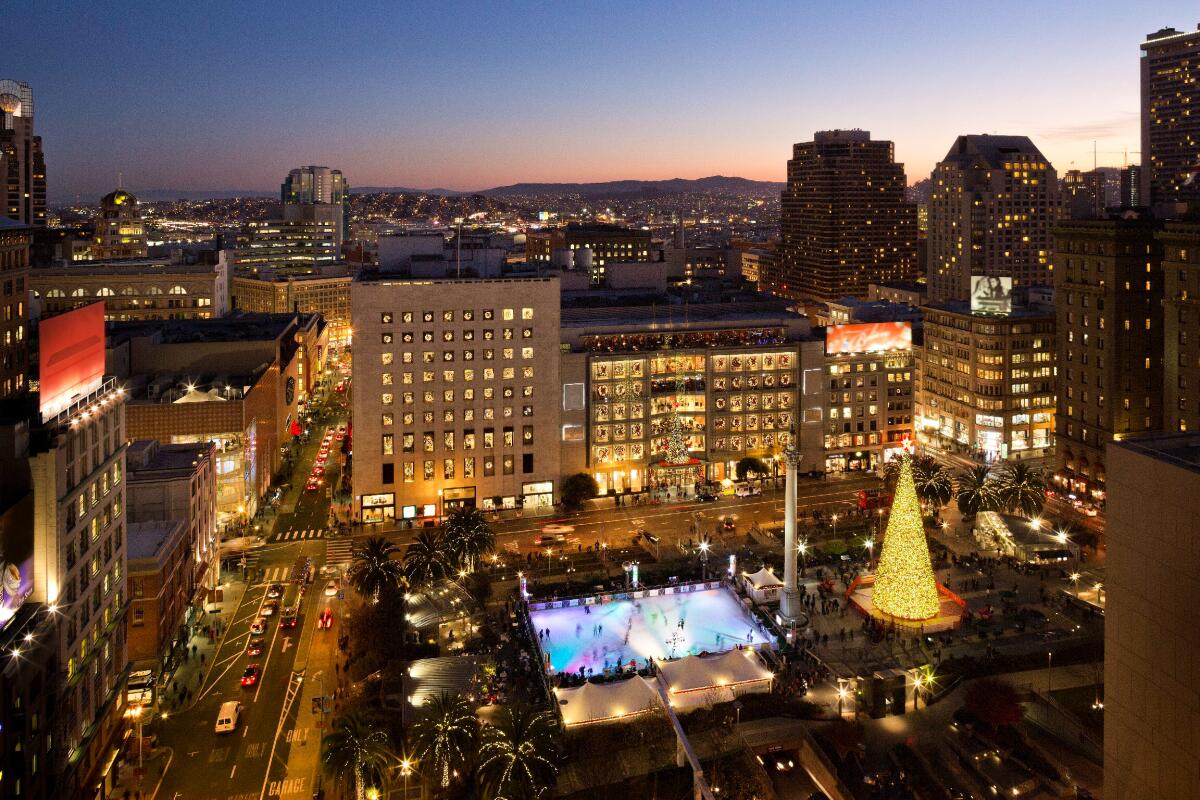
22. Skate or spectate at Union Square, San Francisco
Even now, with San Francisco’s economy flagging amid a shortage of tourists from Asia, Union Square carries urban energy. Cable cars pass on Powell Street, and the square is surrounded by hotels and brand-name shops, including Macy’s (whose holiday displays draw crowds), Apple, Dyson, Gucci, Neiman Marcus and Swarovski.
This winter, the skating rink will open daily through Jan. 16. (For a 60-minute session, it’s $20 general admission, $15 for children age 8 and under, rental skates included.) The Macy’s Union Square Great Tree will stand and glitter through Jan. 1.
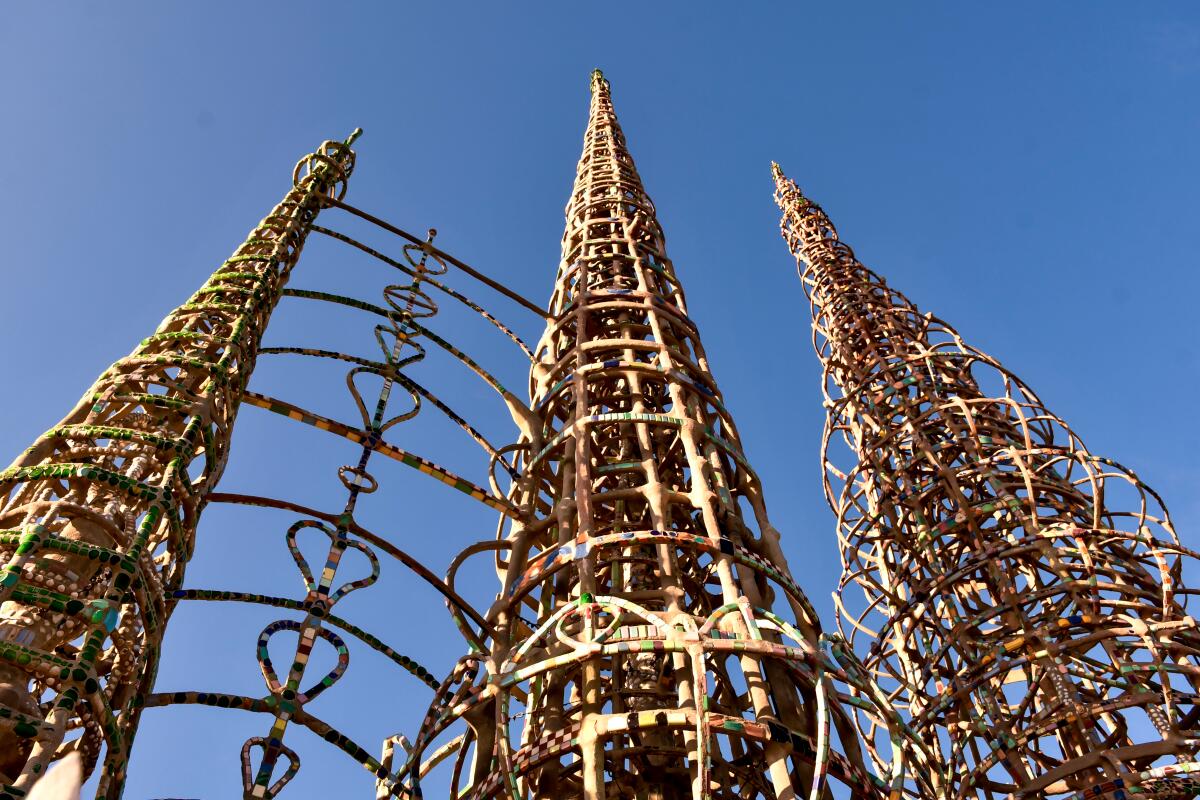
23. Check out Watts Towers
Sabato (Simon) Rodia, an immigrant from Italy, started this backyard project in 1921 and spent 33 years putting up Watts Towers (up to 99 feet high), using rebar, concrete, cast-off tiles, bottle caps and bits of colored glass (especially blue Phillips’ Milk of Magnesia bottles). He walked away in 1954 and died in 1965.
Yet he built so well that his work survived; It has inspired many local children to pursue creative careers (including celebrated assemblage artist Betye Saar and jazz great Charles Mingus). It’s now protected as a state historic park and neighbored by a community arts center. The area inside the triangular property’s walls reopened in November (Wednesdays, Thursdays and Fridays) after several years of renovations and COVID-19 closure. Thirty-minute tours ($7) are offered on Thursdays and Fridays. Whether or not the interior area of the towers is open, you can see plenty from outside the fence.
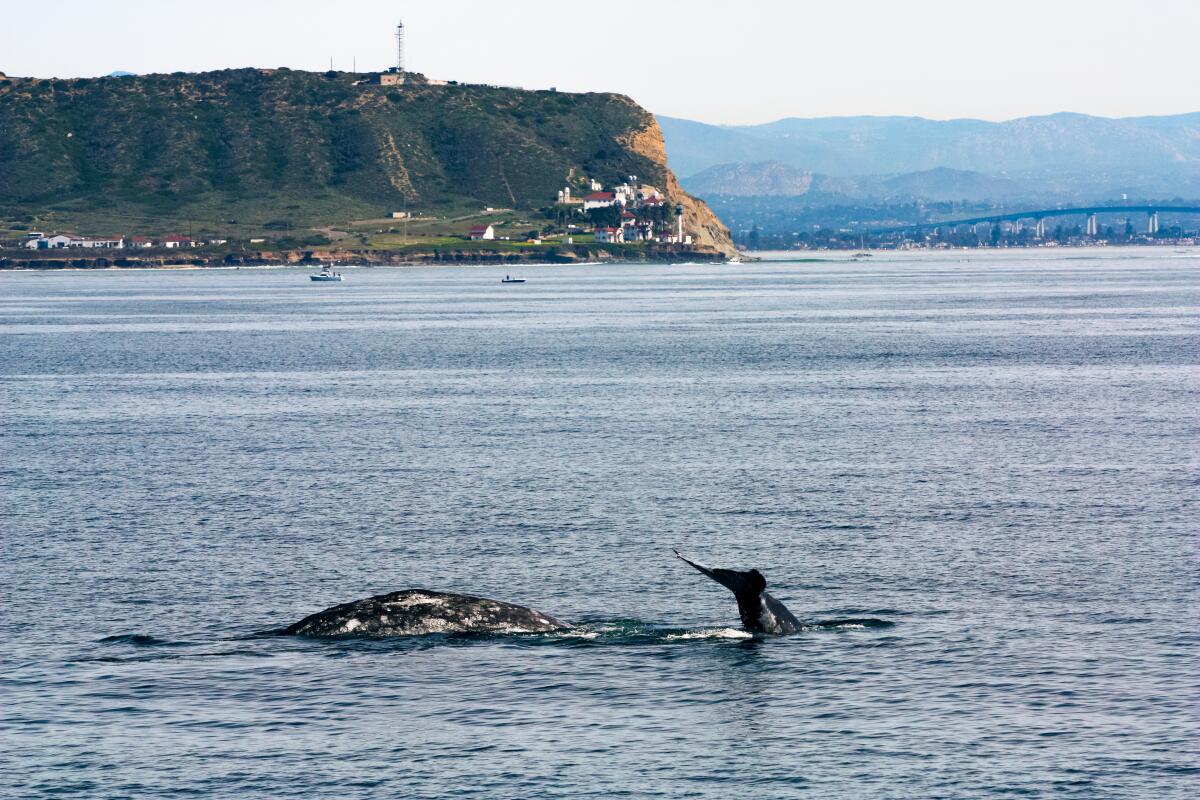
24. Chase whales from San Diego
On any of those boats, you should hear plenty about the wonders of Eschrichtius robustus (the gray whale), which gets up to 49 feet long, often migrating 10,000 miles (round trip) in a year.
Meanwhile, you may come across pods of dolphins — sometimes hundreds, leaping in the surf. Several dolphin species are common in these waters.
San Diego also has a few strong spots for whale watching from land, especially Torrey Pines State Natural Reserve in La Jolla and Cabrillo National Monument on Point Loma.
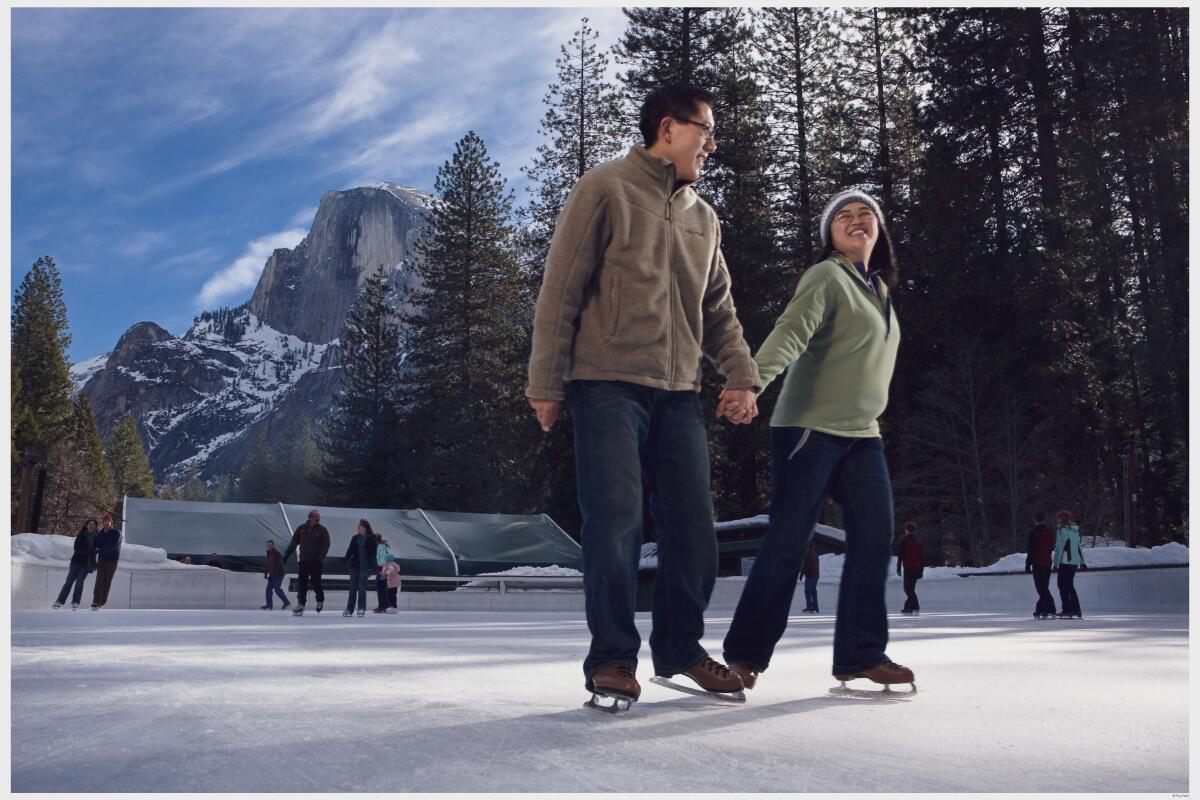
25. Glide around Yosemite's Curry Village Ice Skating Rink
Prices are $16 general admission, $15 per child ages 12 and under; plus $5.25 for skate rentals. Helmets are free. Admission allows up to two hours of skating. Tickets are sold at the Curry Village Tour & Activity Desk, next to the village’s registration office.
Sign up for This Evening's Big Stories
Catch up on the day with the 7 biggest L.A. Times stories in your inbox every weekday evening.
You may occasionally receive promotional content from the Los Angeles Times.
